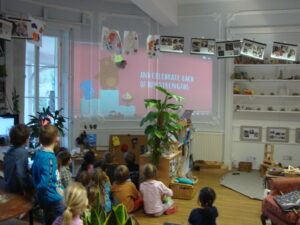![]()

Venturing into the Attenborough (Reception and Year 1) classroom at Atelier 21, the air is filled with an atmosphere of curiosity and wonder. A calm and welcoming space designed to allow the youngest learners in the school feel comfortable and free to move in and out of the rooms and outside space through the open French doors is full of life and expressions as the 20 students busy themselves in many new adventures every day.
Learning power animals grace the shelves, a fun and comforting reminder to the young students of the skills they excel at, those they are developing and those they can offer to a friend who might need a different skill to help them move forwards. Zoned spaces with curved desks hugging the walls, a comfortable rug and a wing backed chair brought from a teachers home to read stories and create worlds in the children’s minds make it a home from home, a space for learning and growing minds and bodies to develop who they are and what they know.
It is neurodiversity awareness week and the young students, aged just 4-6 years old, sit in a circle, their eyes bright with anticipation as they embark on a journey of understanding and exploration. As the topic is introduced, the children listen intently, their young minds eager to absorb new knowledge. The creative teachers Becs and Gloria introduce the topic and set up a video on the subject, the children settle in, their eyes wide with curiosity. With their attention grasped, the video plays accompanied by the occasional wriggling bottom and the gentle shuffling of little feet.
As the video unfolds, the children’s fascination grows, their imaginations ignited by the idea of different brains experiencing the world in unique ways. They exchange knowing glances and excited whispers, their young minds racing to make sense of the new information. The video explores the concept of neurodivergence – highlighting the similarities and differences in how human brains work – the children’s imaginations take flight.
When the video concludes, Becs and Gloria turn to the class, their eyes sparkling with enthusiasm. “What did you think?” they ask, their voices gentle yet encouraging.
The room erupts into a flurry of activity, the children eager to share their thoughts and observations.
“It’s about being yourself,” one child offers, their words echoing the sentiment of the video. “We all think differently,” adds another, their voice filled with excitement. The conversation flows effortlessly, with each child contributing their own unique perspective on the topic at hand.
As the discussion unfolds, the children delve deeper into the concept of neurodivergence. They speak of the importance of acceptance and understanding, of embracing differences and celebrating individuality. Their words are a testament to their understanding of complex concepts and their ability to articulate them with clarity and depth coupled with their innate empathy and compassion.
Reflecting on their own strengths and challenges and sharing personal anecdotes and experiences – from running and playing sports to drawing and making up stories, each child celebrates their unique talents and abilities, recognising the value of perseverance and determination in overcoming obstacles.
In the midst of it all, the essence of neurodivergence becomes clear—a celebration of the rich tapestry of human experience, where differences are not only accepted but embraced with open arms. The children’s voices ring out with joy and enthusiasm, as they revel in the beauty of diversity and the power of acceptance.
As the session comes to a close, the children’s hearts are full, their minds expanded by the insights gained. They leave the classroom with a newfound appreciation for the complexity of the human brain and a deep sense of empathy for others with every individual celebrated for who they are not just what they know.